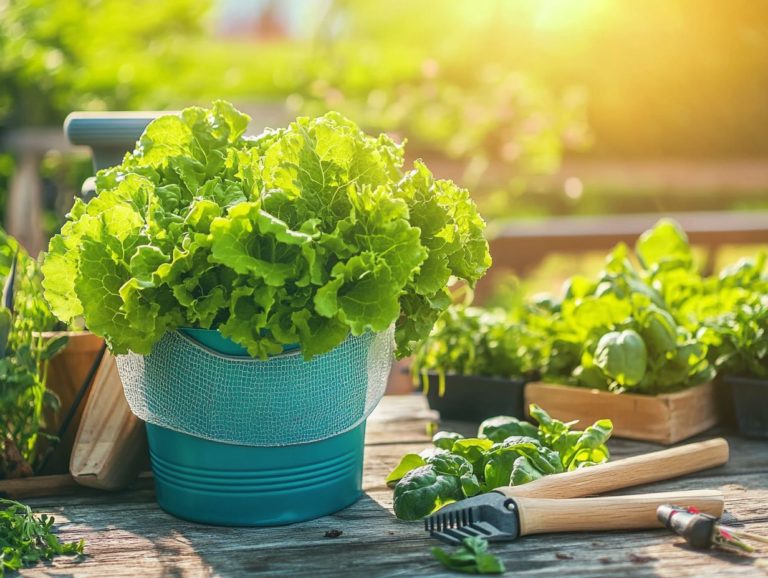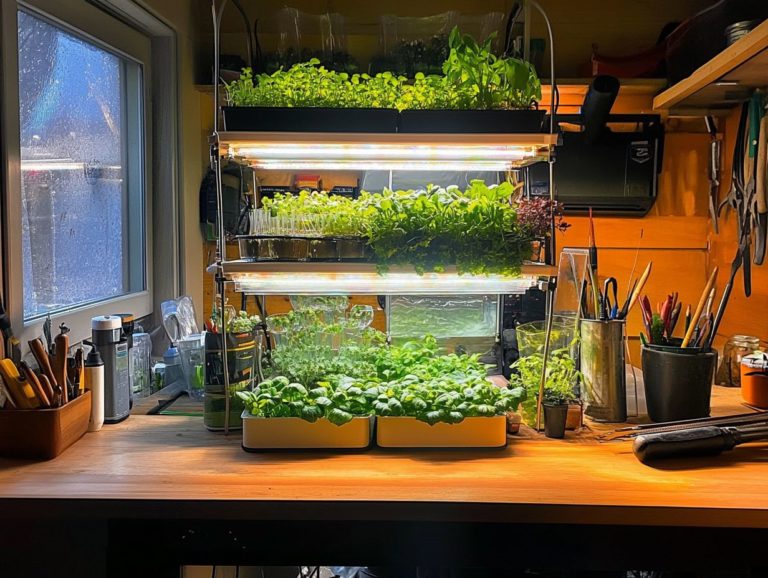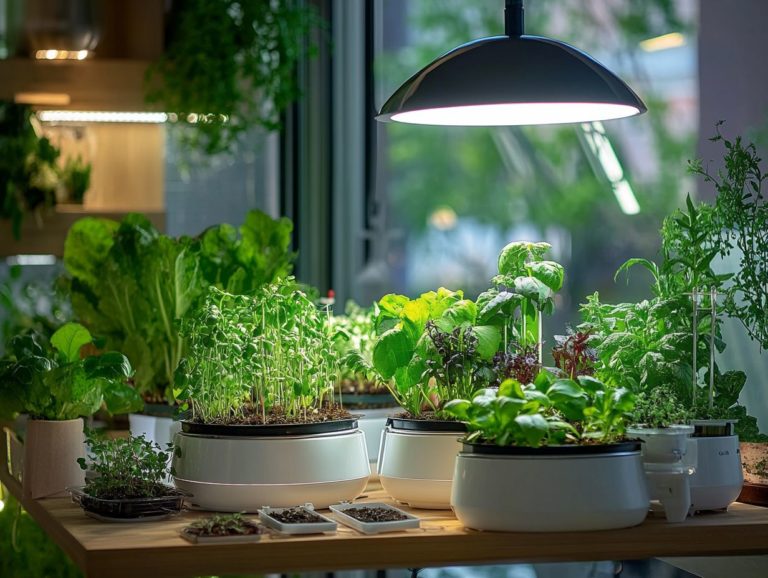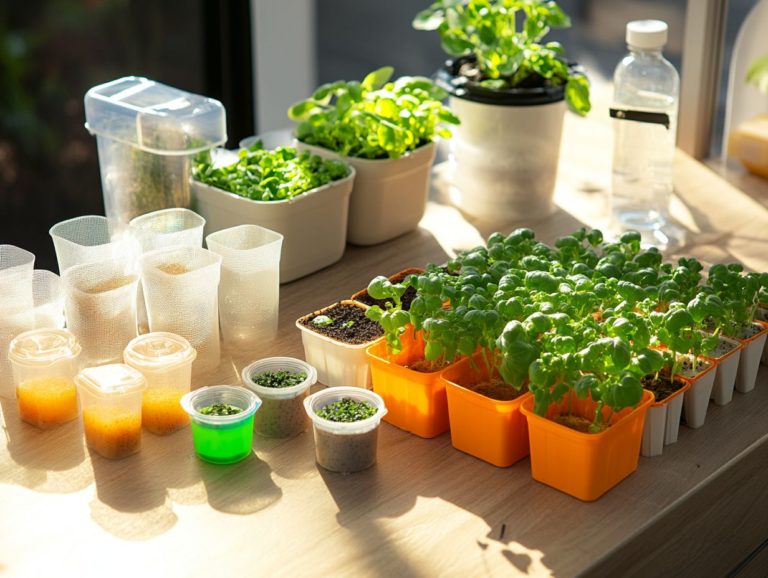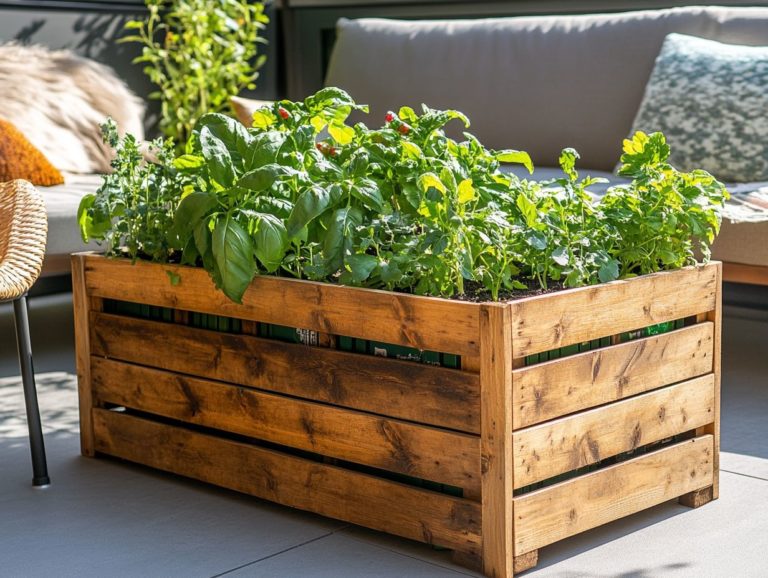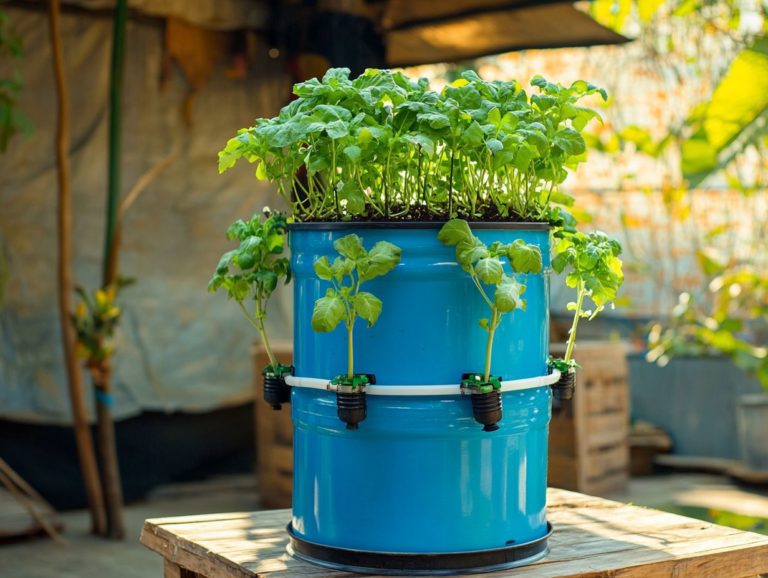How to Build an Aeroponic Hydroponic System
Are you ready to boost your gardening game? Aeroponic hydroponic systems offer a fresh way to grow plants without soil by using a nutrient mist that promotes rapid growth.
This article covers the basics of aeroponics, highlighting its benefits over traditional methods and outlining the materials you ll need to start your journey.
From a detailed step-by-step building guide to troubleshooting tips, you ll find everything you need to create a thriving aeroponic garden and achieve impressive results.
Dive in and discover a new way to garden sustainably!
Contents
- Key Takeaways:
- Understanding Aeroponic Hydroponic Systems
- Benefits of Aeroponic Hydroponic Systems
- Materials and Tools Needed
- Step-by-Step Guide to Building an Aeroponic Hydroponic System
- Troubleshooting and Maintenance
- Tips for Successful Aeroponic Hydroponic Gardening
- Frequently Asked Questions
- What is an aeroponic hydroponic system?
- What are the benefits of using an aeroponic hydroponic system?
- What materials do I need to build an aeroponic hydroponic system?
- How do I set up an aeroponic hydroponic system?
- What types of plants can I grow using an aeroponic hydroponic system?
- Can I build an aeroponic hydroponic system on my own?
Key Takeaways:
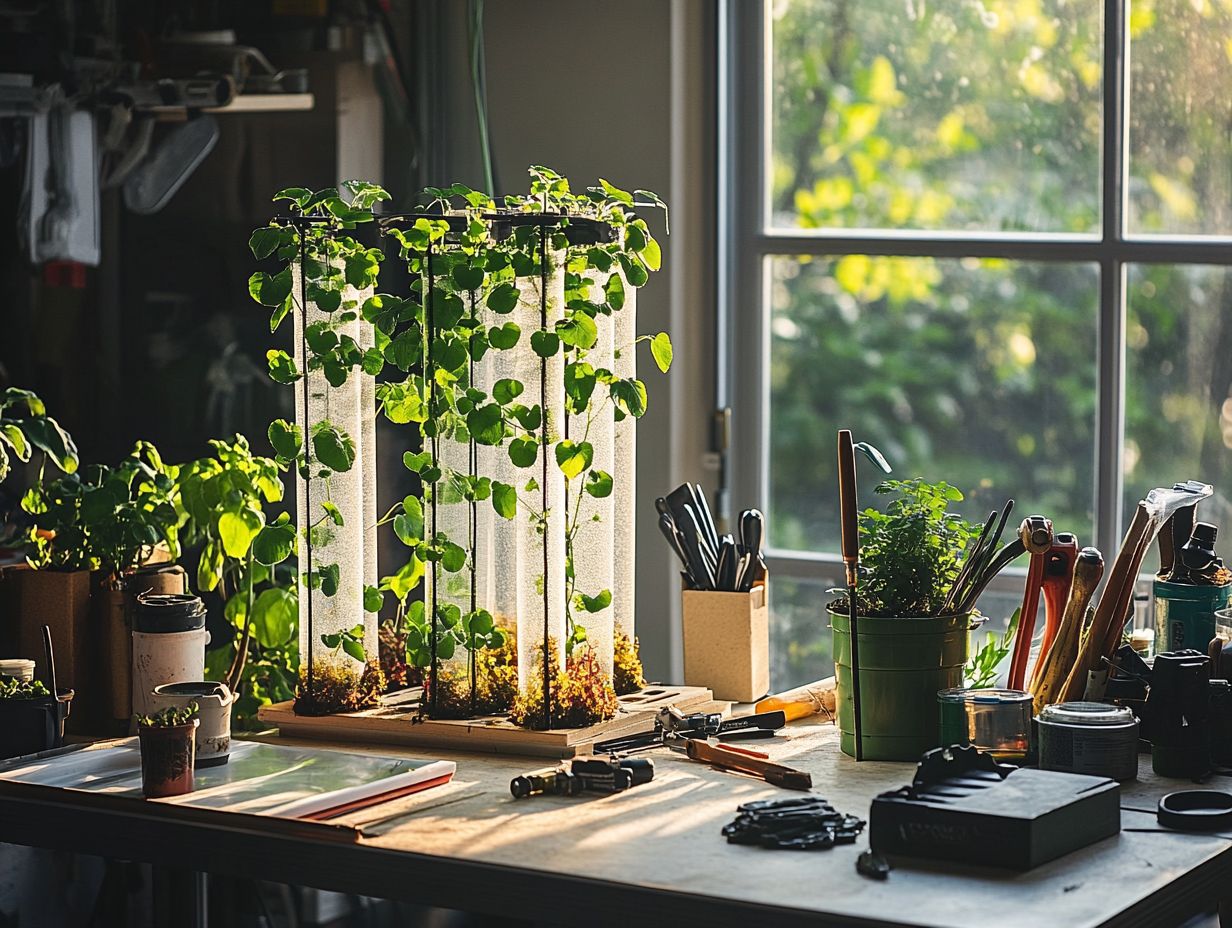
- Aeroponic hydroponic systems use mist instead of soil to grow plants, resulting in faster growth and higher yields.
- Compared to traditional hydroponics, aeroponics offers better control over nutrient intake and reduces the risk of plant diseases.
- Building an aeroponic hydroponic system requires essential components, careful preparation, and regular maintenance for successful gardening.
Understanding Aeroponic Hydroponic Systems
Understanding aeroponic systems is vital for anyone interested in innovative farming techniques. This method combines aeroponics and hydroponics to grow plants efficiently.
With pumps and net pots, you can easily grow various plants like tomatoes and cucumbers. This system offers significant advantages for indoor and outdoor gardening enthusiasts.
What is Aeroponics?
Aeroponics is a method of growing plants without soil by using a nutrient mist. This technique enhances plant health and improves efficiency in water and nutrients.
By growing crops in a controlled environment, you can avoid common issues in soil gardening, such as pests and diseases. Vegetables like lettuce, herbs, and strawberries thrive well in aeroponic systems.
Benefits of Aeroponic Hydroponic Systems
Aeroponic hydroponic systems provide many advantages that can significantly boost your plant-growing efficiency. They use less water and enable faster growth rates by giving plants direct access to nutrients, light, and air.
By reducing the risk of soil-borne diseases, they are ideal for both indoor and outdoor environments. Enjoy cultivating your plants all year round!
Advantages Over Traditional Hydroponics
Aeroponics has numerous benefits over traditional hydroponics, especially regarding efficiency and space utilization. Unlike hydroponics, which often requires larger setups, aeroponics uses a misting system.
This method allows plants to absorb nutrients directly through their roots, conserving water and fostering healthier growth. For those interested in hydroponics, how to set up a deep water culture system can be easier and more adaptable to your unique gardening needs.
Materials and Tools Needed
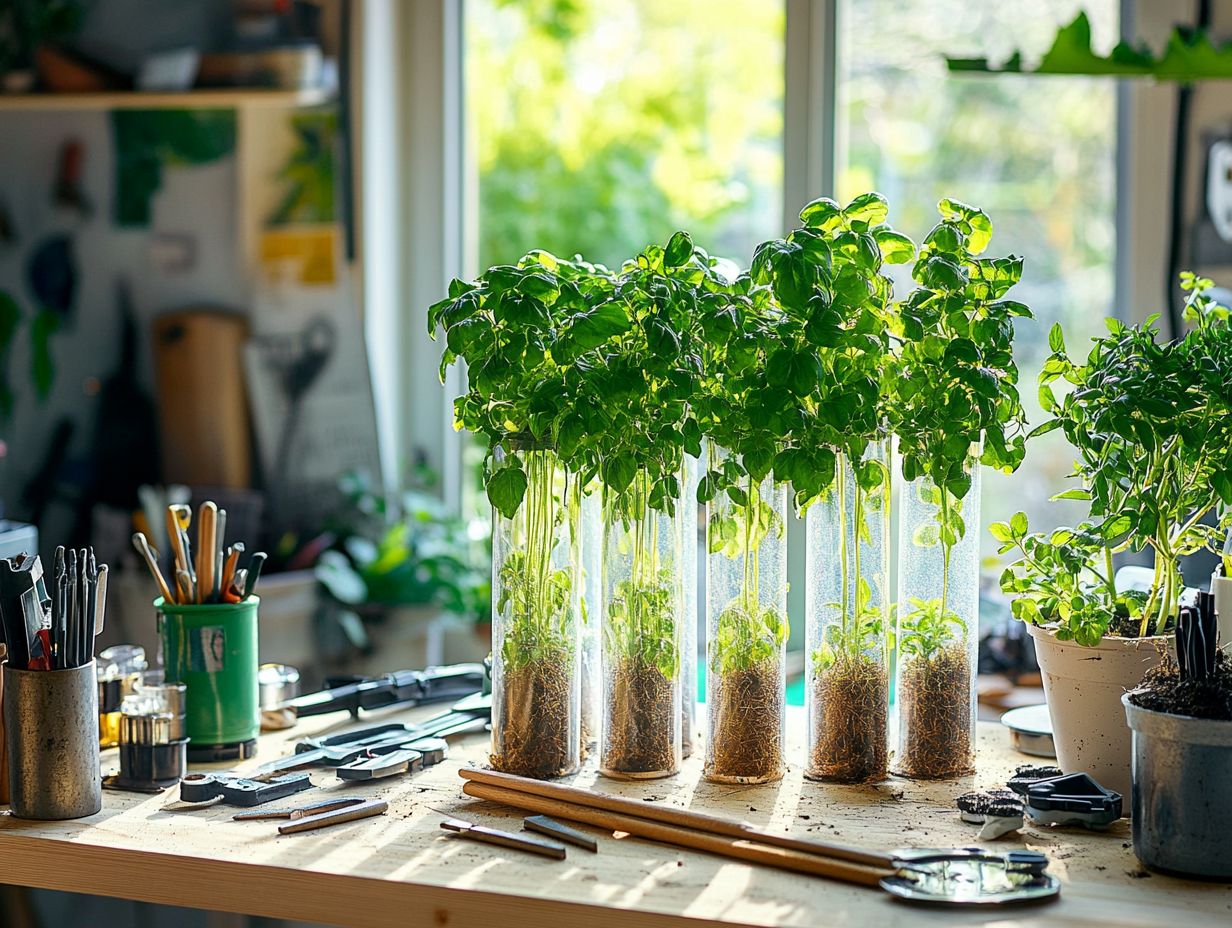
To successfully cultivate your aeroponic hydroponic system, it’s essential to gather the right materials and tools to create an effective growing environment. You ll need a reliable pump for water movement, net pots to cradle your plants, and a reservoir to hold the nutrient-rich water.
Don’t overlook additional elements like fans for air movement and grow lights to mimic sunlight. These components are vital for achieving optimal growth conditions.
Essential Components for Building
Building an aeroponic hydroponic system involves several essential components that work together to create the ideal environment for your plants to thrive.
You ll need a growing chamber, a nutrient delivery system, and a misting mechanism. Each plays a crucial role in the overall functionality of the system.
The growing chamber, typically made from high-quality materials such as PVC or food-grade plastics, forms a sturdy foundation that maximizes light exposure for your plants.
The nutrient delivery system dispenses a finely misted nutrient solution, ensuring the roots receive all the essential elements they need without being submerged in water. The mist helps plant roots absorb nutrients and increases oxygen levels, both essential for healthy growth.
Together, these components create a harmonious ecosystem that maximizes growth potential and resource efficiency, making your hydroponic journey not just effective, but truly rewarding.
Step-by-Step Guide to Building an Aeroponic Hydroponic System
Creating your own aeroponic hydroponic system is an exciting DIY project that can transform your gardening experience! This guide offers precise instructions to help you establish your system, enabling you to nurture your favorite plants whether tomatoes or cucumbers while managing upkeep effectively.
Preparation and Setup
The preparation and setup phase is vital for ensuring that your aeroponic hydroponic system operates smoothly. This requires meticulous attention to key components like the reservoir, pump, and water source.
Before assembly, choose a suitable location that offers ample space and easy access to electrical outlets. Ensure that ventilation is adequate.
Gather all necessary materials in advance, such as nutrient solutions and tubing, to streamline the process.
Setting up the reservoir correctly is essential, as it serves as the heart of your system. Ensuring the pump functions optimally will facilitate the efficient delivery of nutrients.
Ensuring top-notch water quality is critical to your success; don t overlook it, as impurities can harm your plants. Optimal light conditions are equally important for promoting healthy growth.
By taking these preparatory steps seriously, you lay a strong foundation for long-term success in your hydroponic journey.
Building the System
Building your aeroponic hydroponic system is an exhilarating phase that brings your preparations to life, transforming your setup into a thriving environment for plant growth.
As you embark on this journey, follow each step carefully, ensuring a seamless assembly of vital components like the reservoir, misting nozzles, and growing trays.
Start by securely positioning the reservoir in a spot that allows for easy maintenance access.
Next, thoughtfully consider the arrangement of the misting nozzles. Their strategic placement can significantly enhance nutrient delivery and foster robust plant growth.
Effectively integrating these components means ensuring that the nutrient solution flows to each plant while maintaining sufficient airflow. Take the time to calibrate the system, observing how each part interacts and making adjustments to achieve peak performance.
Troubleshooting and Maintenance
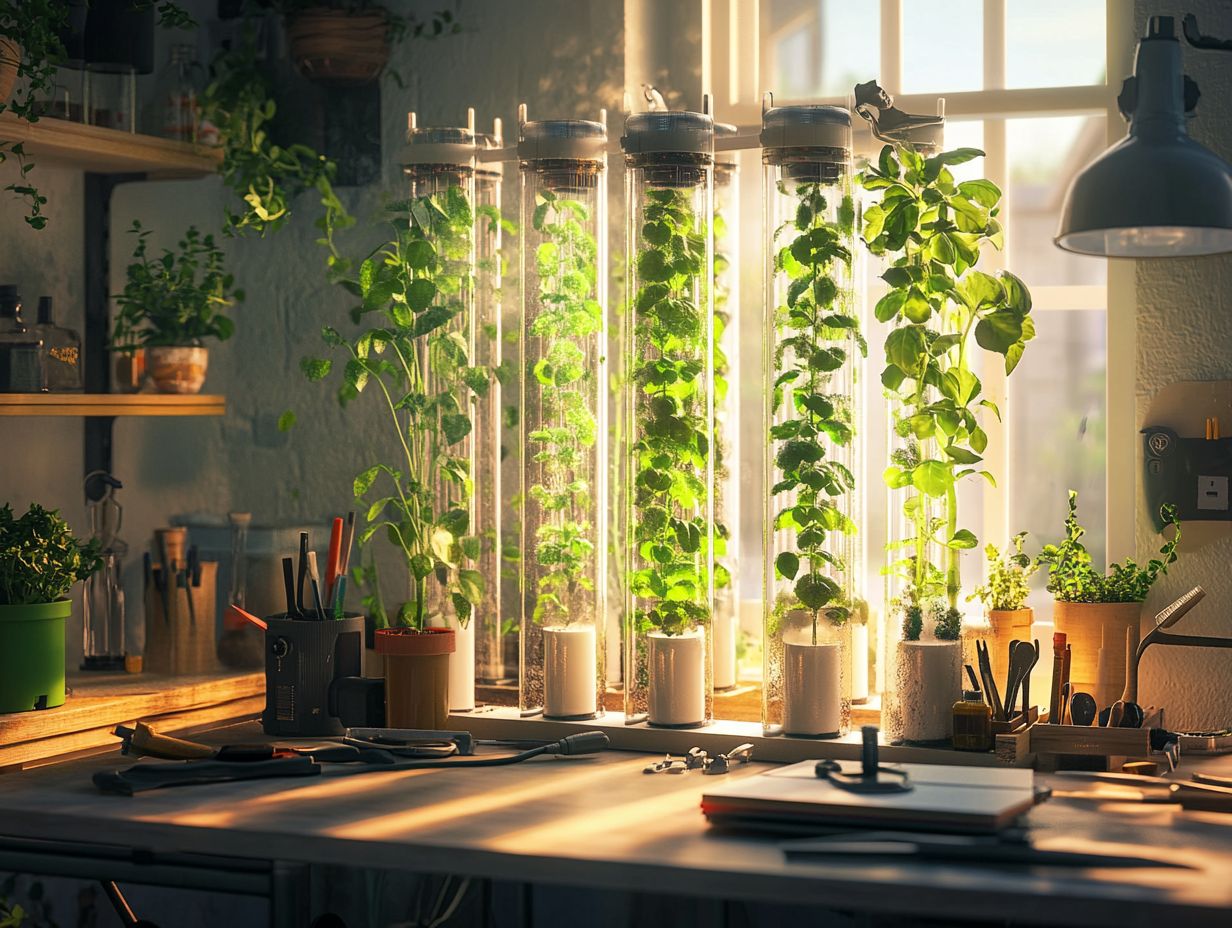
Maintaining your aeroponic hydroponic system is key to ensuring its longevity and efficiency. Familiarizing yourself with common troubleshooting techniques can save you both time and resources.
Regularly checking components such as the pump, water levels, and nutrient balance is essential to prevent any issues that could hinder plant growth.
Common Issues and How to Fix Them
Common issues in aeroponic hydroponic systems can include water quality problems, nutrient deficiencies, and the ever-looming threat of plant diseases like blight. Fortunately, these challenges can be effectively managed with the right troubleshooting techniques.
Water quality plays a crucial role in plant growth. Regular testing and maintaining pH levels between 5.5 and 6.5 can significantly mitigate issues caused by harmful pathogens.
For nutrient deficiencies, monitor the nutrient solution closely and adjust concentrations to meet your plants’ specific needs. Implement an integrated pest management strategy to prevent plant diseases; this involves regular inspections and using beneficial insects like ladybugs or lacewings to control pests.
To ensure overall system efficiency and promote healthy plant growth, use sterile equipment and practice periodic system sanitization. For detailed guidance, see how to maintain your hydroponic growing system. Check that all components are functioning correctly to minimize potential risks.
Regular Maintenance Tasks
Don’t miss out on the magic of healthy plants! Regular maintenance is key to the seamless operation of your aeroponic hydroponic system. This ensures that water and nutrients flow properly and that fans deliver adequate air movement.
To achieve optimal growth, frequently monitor water levels to prevent dry spells that could stress your plants. Adjusting nutrient concentrations is equally crucial, as fluctuations can directly impact your crops’ health.
Consistent cleaning of all components such as pumps, filters, and spray nozzles helps prevent clogs and ensures everything operates smoothly. By committing to these fundamental tasks, you can significantly elevate your system’s efficiency and achieve a more fruitful yield.
Tips for Successful Aeroponic Hydroponic Gardening
To achieve success in aeroponic hydroponic gardening, employ specific techniques and strategies to optimize both plant growth and system performance.
From meticulously setting up your aeroponic system to diligently monitoring environmental conditions, adhering to best practices will pave the way for bountiful harvests of fruits and vibrant blooms like tomatoes and cucumbers.
Best Practices for Optimal Results
Employing best practices in your aeroponic hydroponic system can significantly elevate your results, ensuring that your plants thrive and produce generous yields of your favorite crops.
To achieve optimal performance, focus on several key aspects, including balancing nutrients, light management, and environmental controls. For example, regularly monitor the nutrient solution’s pH which measures acidity and EC (Electrical Conductivity) levels to maintain the right balance for plant uptake, ensuring they receive the vital minerals needed for growth.
Manage light exposure carefully; using LED grow lights with the appropriate spectrum can effectively mimic natural sunlight and boost photosynthesis. Control environmental conditions like humidity and temperature to create an ideal habitat for your plants, promoting robust health and productivity.
By integrating these practices, you can cultivate a flourishing aeroponic garden that thrives throughout the year, maximizing your growing space.
Frequently Asked Questions
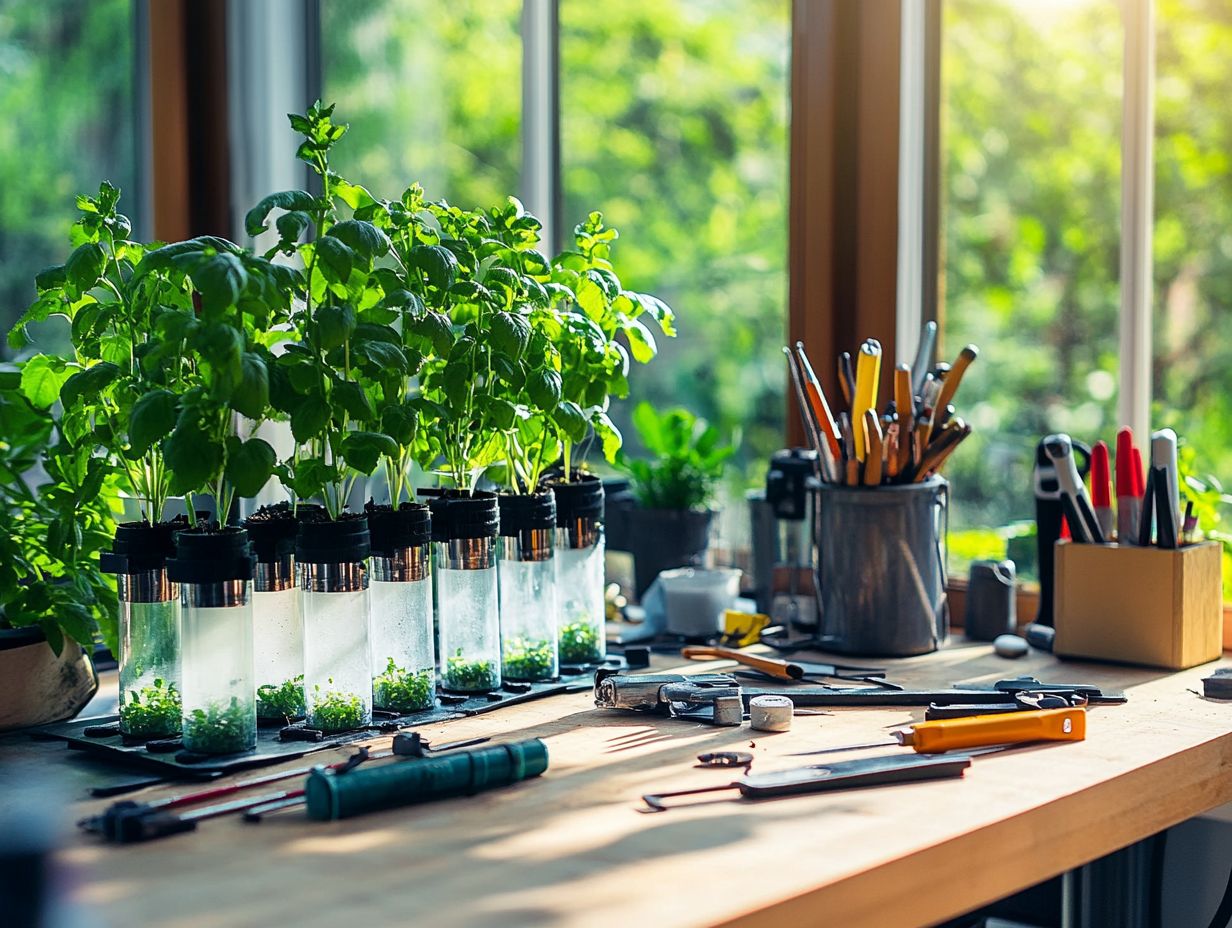
What is an aeroponic hydroponic system?
An aeroponic hydroponic system is a method of growing plants without soil. Instead, plants grow in a soilless environment using water and nutrients delivered directly to their roots through a misting system, which provides a highly oxygenated and nutrient-rich environment for plant growth.
Ready to start your own aeroponic hydroponic system? Take the plunge and watch your garden flourish!
What are the benefits of using an aeroponic hydroponic system?
There are several benefits to using an aeroponic hydroponic system. It leads to faster growth rates and higher yields. Plants also absorb nutrients better with this method.
It saves water and space, and eliminates the need for pesticides. This makes it an environmentally friendly option for growing plants.
What materials do I need to build an aeroponic hydroponic system?
To build your aeroponic hydroponic system, you will need a reservoir, a pump, tubing, misters, a timer, growing containers, net cups, and a growing medium.
You may also need a pH meter, a tool to measure the total dissolved solids in water, and plant food mixed with water depending on your setup.
How do I set up an aeroponic hydroponic system?
Start by choosing a suitable location and gathering all the necessary materials. Install the misting system and connect the timer and pump.
Then, fill the reservoir with your nutrient-rich water. Place the plants in the growing containers with the growing medium, and connect the tubing to the misters.
Finally, set the timer and adjust the misting intervals as needed.
What types of plants can I grow using an aeroponic hydroponic system?
An aeroponic hydroponic system can grow a wide variety of plants. This includes herbs, leafy greens, vegetables, and even some fruit crops.
However, it is not suitable for root vegetables or large plants with deep root systems.
Can I build an aeroponic hydroponic system on my own?
Absolutely! Building your own aeroponic hydroponic system is not only possible but fun!
It s a simple and cost-effective way to grow plants. There are many online resources and tutorials available to guide you through the process.
Be sure to research and plan before starting, and follow proper safety precautions when handling any tools or equipment.
Start your aeroponic journey today and enjoy fresh produce right at home!

